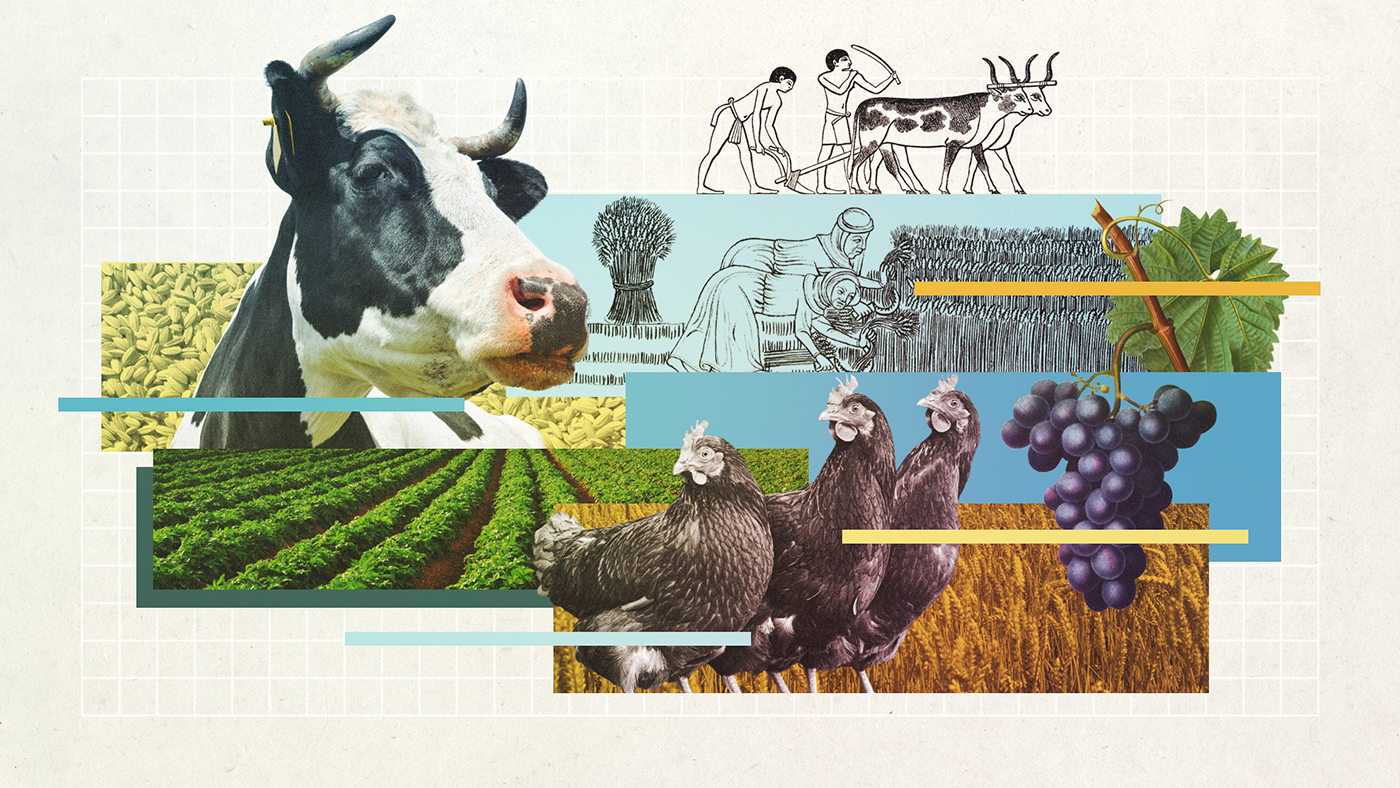Agriculture explained in 60 seconds: ideas that changed the world
How seeds and selective breeding paved the way for civilisation


In this series, The Week looks at the ideas and innovations that permanently changed the way we see the world.
Agriculture in 60 seconds
Agriculture refers to the cultivation and exploitation of animals, plants and other forms of organic life for human use, covering everything from food and fibre to medicines and fuel.
In many respects, the history of agriculture is the history of humankind, with early humans’ ability to form fully-fledged societies almost entirely facilitated by the harnessing of crops. During the first so-called agricultural revolution, around 12,000 years ago, developing a mastery of agriculture allowed communities to support themselves on a scale and level of efficiency never seen before.
The Week
Escape your echo chamber. Get the facts behind the news, plus analysis from multiple perspectives.

Sign up for The Week's Free Newsletters
From our morning news briefing to a weekly Good News Newsletter, get the best of The Week delivered directly to your inbox.
From our morning news briefing to a weekly Good News Newsletter, get the best of The Week delivered directly to your inbox.
Where humans previously had followed a nomadic lifestyle of hunting and gathering, new knowledge and skill in cultivating land and growing plants “advanced the development of human society, allowing clans and tribes to stay in one location generation after generation”, with these settled communities gradually evolving into villages, towns and cities, said the New World Encyclopedia.
Agriculture also enabled trade relations between different regions and groups of people, paving the way for the advancement of societies, sharing of ideas and resources, and an explosion in the global population.
Today, despite technological advancements that have mechanised many agricultural processes – while also having a mixed impact on the environment – farming and related industries support many millions of workers across the globe, and will continue to shape the future of humanity.
How did it develop?
Identifying when agriculture first started is “complicated”, said NPR.
A free daily email with the biggest news stories of the day – and the best features from TheWeek.com
It is believed to have developed “at multiple times in multiple areas, the earliest of which seems to have been in Southwest Asia”, said the New World Encyclopedia.
The earliest evidence of farming is from about 12,000 years ago, during the Neolithic Era, the final division of the Stone Age. These farmers lived in the Fertile Crescent, an area in the Middle East that includes modern-day Iraq, Jordan, and Israel, among other countries. “This region kick-started the Neolithic Revolution,” said National Geographic.
Evidence of potentially separate agricultural development from the same era has also been found on the Yangtze River in China.
“There was no single factor, or combination of factors, that led people to take up farming in different parts of the world,” National Geographic added. The varying catalysts could have included changes to the climate, or “increased pressure on natural food resources”.
The first crops to be deliberately cultivated by humans include emmer wheat, einkorn wheat, peas, lentils, bitter vetch, barley, chickpeas and flax. By 7,000BC, farmers had also begun to domesticate animals such as sheep, pigs and goats. About a thousand years later, they domesticated cattle.
From here, other technological innovations followed. “Irrigation (circa 6,000BC) and the plough (circa 3,000BC) brought enormous gains in productivity,” and civilisations all over the world acquired advanced metalworking techniques that further improved yield, said the Center for a Livable Future at the Maryland-based Johns Hopkins University.
Between the 17th century and 19th century, the UK and other developed countries experienced a dramatic increase in agricultural output dubbed the Second Agricultural Revolution, during which workers introduced new crops to their farms, developed new methods of harvesting, and extended the types of land that could be used.
By the 20th century, agricultural technology was developing more rapidly than ever before. Although “the most important developments during the first half of the century took place in the industrial countries”, the picture “changed somewhat after the 1950s” as “former colonies in Africa and Asia initiated large-scale efforts to improve their agriculture” by adapting Western methods to their differing soil types and climates, said Encyclopedia Britannica.
How did it change the world?
“Farming sowed the seeds for the modern age,” said National Geographic.
The first agricultural revolution in the Neolithic period saw humans transition from a nomadic life of hunting and gathering to farming in a fixed location – a launching point from which to build settled communities and, later, civilisations.
The second revolution, during the early modern era, is considered to be one of the main causes of the Industrial Revolution that took hold in the mid-1800s, as improved agricultural productivity freed up workers for employment in other sectors of the economy. The two movements also effectively fed into each other, with agricultural advances allowing more workers to take jobs in cities, while industrial advances further increased farming yields and productivity.
During the latter half of the 20th century, agriculture became hugely successful in meeting a growing demand for food by the world’s endlessly increasing population. “Yields of primary crops such as rice and wheat increased dramatically, the price of food declined, the rate of increase in crop yields generally kept pace with population growth, and the number of people who consistently go hungry was slightly reduced,” explained Encyclopedia.com.
However, the environmental effects of agriculture might also threaten the future of humanity. In 1700, only 7% of Earth’s surface was used for agriculture: today that figure is nearly 40%, according to the Food and Agriculture Organization of the United Nations (FAO).
Agriculture is “the leading source of pollution in many countries,” said the World Wildlife Fund. Chemicals used to improve production, including pesticides and fertilisers, seep into the surrounding ecosystems and “can remain in the environment for generations.”
Farming requires huge amounts of water: around 70% of the world’s fresh water withdrawals go toward agriculture. Food production is also responsible for 26% of global greenhouse gas emissions, and the majority of those emissions come from raising livestock and farming crops for human food.
Although more recent technological changes including GMO crops and other developments in hardware and software will “boost farmers’ profits” and lower prices in the short term, how can the world be fed in the long-term “without putting irreparable strain” on the Earth, asked The Economist.
“Reducing emissions from food production will be one of our greatest challenges in the coming decades,” said Our World in Data. “We will need a menu of solutions: changes to diets; food waste reduction; improvements in agricultural efficiency; and technologies that make low-carbon food alternatives scalable and affordable.”
Jessica Hullinger is a writer and former deputy editor of The Week Digital. Originally from the American Midwest, she completed a degree in journalism at Indiana University Bloomington before relocating to New York City, where she pursued a career in media. After joining The Week as an intern in 2010, she served as the title’s audience development manager, senior editor and deputy editor, as well as a regular guest on “The Week Unwrapped” podcast. Her writing has featured in other publications including Popular Science, Fast Company, Fortune, and Self magazine, and she loves covering science and climate-related issues.
-
 US citizens are carrying passports amid ICE fears
US citizens are carrying passports amid ICE fearsThe Explainer ‘You do what you have to do to avoid problems,’ one person told The Guardian
-
 All roads to Ukraine-Russia peace run through Donetsk
All roads to Ukraine-Russia peace run through DonetskIN THE SPOTLIGHT Volodymyr Zelenskyy is floating a major concession on one of the thorniest issues in the complex negotiations between Ukraine and Russia
-
 Why is Trump killing off clean energy?
Why is Trump killing off clean energy?Today's Big Question President halts offshore wind farm construction
-
 How Bulgaria’s government fell amid mass protests
How Bulgaria’s government fell amid mass protestsThe Explainer The country’s prime minister resigned as part of the fallout
-
 Femicide: Italy’s newest crime
Femicide: Italy’s newest crimeThe Explainer Landmark law to criminalise murder of a woman as an ‘act of hatred’ or ‘subjugation’ but critics say Italy is still deeply patriarchal
-
 Brazil’s Bolsonaro behind bars after appeals run out
Brazil’s Bolsonaro behind bars after appeals run outSpeed Read He will serve 27 years in prison
-
 Americans traveling abroad face renewed criticism in the Trump era
Americans traveling abroad face renewed criticism in the Trump eraThe Explainer Some of Trump’s behavior has Americans being questioned
-
 Nigeria confused by Trump invasion threat
Nigeria confused by Trump invasion threatSpeed Read Trump has claimed the country is persecuting Christians
-
 Sanae Takaichi: Japan’s Iron Lady set to be the country’s first woman prime minister
Sanae Takaichi: Japan’s Iron Lady set to be the country’s first woman prime ministerIn the Spotlight Takaichi is a member of Japan’s conservative, nationalist Liberal Democratic Party
-
 Russia is ‘helping China’ prepare for an invasion of Taiwan
Russia is ‘helping China’ prepare for an invasion of TaiwanIn the Spotlight Russia is reportedly allowing China access to military training
-
 Interpol arrests hundreds in Africa-wide sextortion crackdown
Interpol arrests hundreds in Africa-wide sextortion crackdownIN THE SPOTLIGHT A series of stings disrupts major cybercrime operations as law enforcement estimates millions in losses from schemes designed to prey on lonely users
